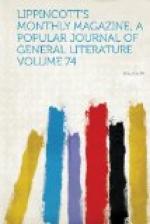Some twelve years had elapsed when I first saw Powers in Florence since the old days in Cincinnati. In such a space of time, especially at that period of life which turns a lad into a man, most men change much. But the change in Powers’s face was but small: I should have known him if I had met him in the street anywhere. But in person he was much changed: he had become stout and what is called personable, not fat—he never was that to the end of his life—but neither was he lanky, as he had been as a youth. He had filled out, as the phrase is, and might be considered in all respects a decidedly handsome man. There was something specially, and more than commonly, upright in the carriage of his person and of his head, which seemed the expression of the uprightness of the man’s moral and intellectual nature and character. He always looked straight at you with those large, placid and generally grave eyes of his under their large and bushy brows. They seemed to continue grave, or at least thoughtful, those eyes, even when there was a pleasant genial smile on the mouth. And there was this specialty about his smile—a specialty which may be often observed in subjective natures habituated to original thought and to live in the inner life: it seemed generally to be produced more by the movement of his own inward feelings and thoughts than by what was said by others. Like most dark-haired men, he began to become gray early in life, and for some few years before his death his appearance was venerable in no ordinary degree. He then wore his hair, which had become perfectly white, very long, and a shallow, very broad-brimmed white hat on the top of it. The latter, indeed, was, I think, at all times his universal wear. I do not think that I ever saw him in Florence in that detestable article of apparel called “a chimney-pot hat.” But this is anticipating.
Very shortly after our arrival in Florence and the renewal of our friendship with Powers—I think not more than a year—there arrived in Florence, bringing a letter of introduction to my mother, an English gentleman of fortune, Mr. Grant. He was a noted lover and patron of art, and my mother proposed to him a visit to the Studio Powers. The sculptor had then just completed his first imaginative work, the “Greek Slave,” which numerous replicas have since made so well known on both sides of the Atlantic. This work had greatly excited my mother’s admiration, and it was that he might have an opportunity of seeing the “Greek Slave” that my mother was desirous of taking Mr. Grant to the sculptor’s studio. But it was not altogether easy to induce Mr. Grant to accept the proposal. “If there is anything very good, that is the very reason why I must not go there. Lead me not into temptation! I have been spending all my money, and more than I meant to spend, on sculpture in Rome. Don’t show me any more statues, for I cannot buy any more.” But this confession of fearing temptation was calculated to produce a




